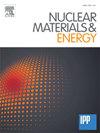铍和铍化钛的高剂量中子辐照:总结与展望
IF 2.7
2区 物理与天体物理
Q1 NUCLEAR SCIENCE & TECHNOLOGY
引用次数: 0
摘要
在模拟DEMO繁殖毯操作环境的条件下,在高通量反应堆材料测试堆中进行辐照实验,以及随后对辐照后的铍基材料(如纯铍和铍化钛)进行辐照后检查(pie),从而对其作为中子倍增器的潜在用途的耐辐射性进行了比较分析。pie清楚地证明了铍化钛比铍的优越性,特别是在减少膨胀、降低氚潴留和在高温下增强机械性能方面。因此,在氦冷球床(HCPB) DEMO繁殖毯设计中,提出了铍化钛块代替铍卵石的方案。成功开发了一种制造铍化钛块的生产技术,并概述了该技术的进一步发展,以及对全尺寸块的研究。本文章由计算机程序翻译,如有差异,请以英文原文为准。
High-dose neutron irradiation of beryllium and titanium beryllide: Summary and outlook
The irradiation experiment conducted in the HFR material testing reactor, under conditions simulating the operating environment of the DEMO breeding blanket, along with subsequent post-irradiation examinations (PIEs) of irradiated beryllium-based materials—such as pure beryllium and titanium beryllide—enabled a comparative analysis of their radiation resistance for potential use as neutron multipliers. The PIEs clearly demonstrated the superiority of titanium beryllide over beryllium, particularly in terms of reduced swelling, lower tritium retention, and enhanced mechanical properties at elevated temperatures. As a result, titanium beryllide blocks have been proposed to replace beryllium pebbles in the Helium-Cooled Pebble Bed (HCPB) DEMO breeding blanket design. A production technology for fabricating titanium beryllide blocks was successfully developed, and further advancements in this technology, along with research on full-scale blocks, have been outlined.
求助全文
通过发布文献求助,成功后即可免费获取论文全文。
去求助
来源期刊

Nuclear Materials and Energy
Materials Science-Materials Science (miscellaneous)
CiteScore
3.70
自引率
15.40%
发文量
175
审稿时长
20 weeks
期刊介绍:
The open-access journal Nuclear Materials and Energy is devoted to the growing field of research for material application in the production of nuclear energy. Nuclear Materials and Energy publishes original research articles of up to 6 pages in length.
 求助内容:
求助内容: 应助结果提醒方式:
应助结果提醒方式:


